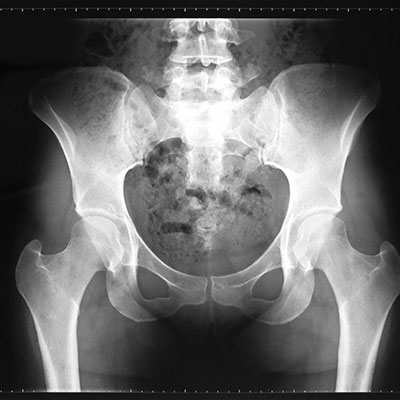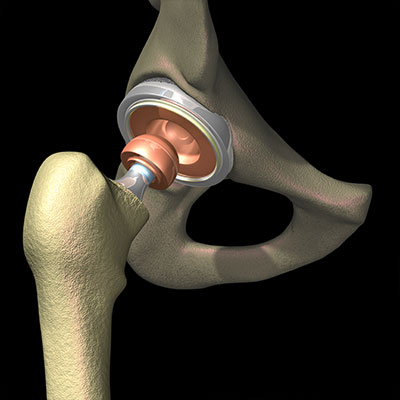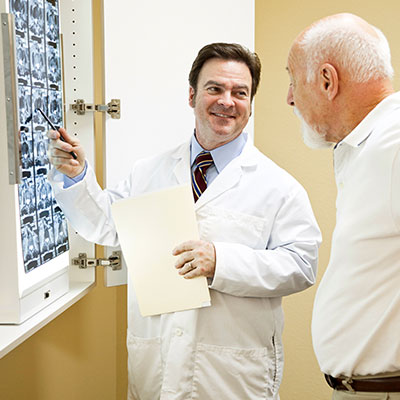Types of Hip Pain
Chronic hip pain can change your life by limiting your ability to walk, sit comfortably or perform normal daily activities. When hip pain interferes with your ability to do the things you want or need to do each day, it’s time to seek medical advice.
What are the different types of hip pain?
Hip pain has many causes. Some of the most common conditions causing hip pain include:
Osteoarthritis
Osteoarthritis is a wearing down of the cartilage that covers our joints, it prevents bones from gliding smoothly over one another. It is one of the most common causes of hip pain, especially as we age. As the cartilage wears away, the head of the thigh bone rubs directly against the hip socket. Bare bone and uneven bone surfaces can cause pain and interfere with normal hip movement.
Pain in the groin, front of the thigh, and outside part of the hip are the most common areas of pain for hip arthritis, especially when walking or during activities that require twisting, such as putting on socks or getting out of a car. The pain is caused by the bones rubbing against each other. The hip joint also may become swollen and stiff.
Hip Fractures
All age groups can sustain a hip fracture but older individuals are more susceptible to breaking a hip during normal everyday activities. Older individuals can be at an even further risk if their bones are weak from osteoporosis. Although osteoporosis chiefly affects women, men over 65 are at risk as well. Hip fractures are medical emergencies and often require immediate surgery.
In addition, younger active individuals can develop stress fractures of the hip. When muscles become fatigued, they fail to absorb the shock of impact from jumping and other activities, and forces are transferred to the bone itself, causing tiny cracks. Stress fractures in the hip joint can cause pain.
Bursitis
Bursitis is inflammation of a fluid-filled sac that lies between our skin and a bone, such as the knee, elbow and the outside of the hip. Possible causes are injury or overuse. Trochanteric bursitis affects the outer surface of the hip joint, producing pain when lying on the affected side, standing up, walking, climbing steps or driving. Treatment typically consists of anti-inflammatories, stretching, physical therapy and injections.
Osteonecrosis
Osteonecrosis can be defined as a process where the bone loses blood supply causing bone cells to die. There are many causes of this condition, but the most common are trauma, blood disorders, sickle cell disease, steroid use, alcoholism or radiation. The hip is the most common site affected by osteonecrosis. Treatment options are many and diverse. Early consultation with a hip expert is recommended.
Tendonitis
The tendons are the rope-like tissues connecting muscles to bone and can become painfully inflamed by repetitive or strenuous movement. Tendonitis is a common sports injury, caused by overuse of the same parts of the body. Treatment commonly consists of temporary activity restriction, anti-inflammatory medication and physical therapy.
Strains
Strains are small tears in a muscle from overuse or irritation. Hip and lower back strains can be caused by twisting, quickly turning or “pulling” the muscles. Strengthening of your abdominal muscles, can be helpful in prevention.
Falls and heavy lifting can injure the discs or the “shock absorbers” in the spinal column. They separate and cushion the vertebrae, but as we age, the discs become more brittle and can rupture, or herniate. Pain from a ruptured disc in the lower spine can radiate down the nerve extending from the spinal cord to the leg. This is known as sciatica. Avoiding movement that causes pain and taking pain medication can relieve symptoms in most people within a few weeks. In some cases, your doctor may recommend surgery if the pain does not subside.
Septic Hip
Septic hip, is an infection of the hip joint which develops most commonly in young children and older adults. Bacteria enter the bloodstream and settle in the hip resulting in pain and limping. This hip pain can commonly be accompanied by fever, along with warmth and redness over the hip. Severe pain, especially with movement, can be felt in the affected joint. A septic hip requires an accurate diagnosis often requiring surgery to clean the infection along with administration of antibiotics.
The hip labrum is a ring of cartilage that surrounds the socket of the hip joint. It provides stability to the joint. The labrum may become injured, torn or painful due to an accident, sports injury or, more commonly, occur over time when the ball portion of the joint rubs abnormally against the socket or doesn’t have the full range of motion. Treatment may include non-steroidal anti-inflammatories, physical therapy or activity modification/rest. If this fails, corticosteroid injections or surgery may be needed.
Diagnosis

How is hip pain diagnosed?
If you develop hip pain that persists, physicians in Cleveland Clinic’s Orthopaedic & Rheumatologic Institute can help sort out the possible causes.
When diagnosing any hip pain, the physician will take your medical history and perform a thorough physical examination. To help your doctor best understand your hip pain, you’ll need to provide the following information:
- A description of your hip pain (aching, tenderness, burning, or swelling)
- Where the pain is located and when it occurs
- When the pain started (and if it is the result of an injury or accident)
- Anything that makes the pain worse or better
Your doctor may also order imaging tests to view the joint, which may include the following:
X-rays — X-rays can show if there are bone changes within your hip.
MRI — If an X-ray looks normal, your doctors may order a magnetic resonance imaging (MRI) scan. An MRI uses magnets and radio waves to provide detailed images of soft tissues, including muscle, tendon and ligaments.
CT scan — A computerized tomography (CT) scan shows fine detailed, cross-sectional and 3-D images of bony abnormalities and to a lesser degree tendon problems. It is best used to evaluate issues with the bones and often obtained for pre-surgical planning purposes and decision making.
Ultrasound – Ultrasound is a non-invasive test that gives physicians a real-time view of the surrounding muscles and tendons of the hip. Plus, it does not expose patients to radiation and may be a good alternative for patients who may be unable to get an MRI or CT scan.
Non-surgical Treatments
How is hip pain treated?
Many types of hip pain can be resolved with conservative treatments such as:
Rest
When the hip is inflamed, as in bursitis, tendonitis or arthritis, it’s important to rest the joint and avoid overusing it.
Ice
Applying cold packs, ice bags or even a bag of frozen peas to the hip can decrease pain as well as reduce inflammation and swelling. Commonly you would apply the ice for up to 20 minutes at a time. Be sure to put a thin cloth between the ice and your skin.
Physical Therapy
Once your doctor diagnoses the cause of your hip pain, physical therapists can show you stretches and exercises to increase flexibility and strength in the hip. Physical therapists can also advise you about helpful aerobic exercises, such as swimming, aqua therapy or cycling, which won’t aggravate hip pain as high-impact activities would. For problems such as bursitis, they can use ultrasound and massage techniques. Finally, physical therapists will show you good “body mechanics” – the proper ways to sit, stand, lift and sleep – to avoid aggravating the hip.
Weight Loss
Weight loss can sometimes be beneficial by lowering the force across the joint and decreasing how hard the muscles have to work. The lower half of your body’s joints, particularly your knees and hips — bear most of your weight. The more weight on the joint, the more wear and tear on the cartilage between the bones. That’s why years of carrying around excess weight can contribute to achy, swollen, stiff joints. Weight loss can assist by taking stress off your joints to ease your symptoms
Over-the-counter medications
Hip pain can be often relieved with over- the- counter- medications including non-steroidal anti-inflammatory drugs (NSAIDs) such as ibuprofen (Advil®) or naproxen (Aleve®), and anti-analgesia (pain-relieving) medications such as acetaminophen (Tylenol®). There are also some topical creams and ointments such as Volaren® that provide temporary numbing relief.
Prescription medications
If over-the-counter medications don't provide relief, prescription-strength NSAIDs can be prescribed. Opioid medications are rarely ever prescribed except in the early post-surgical period or in the setting of a significant fracture, as opioids are not very helpful outside of these two scenarios.
Injections
When other treatments don’t help severe hip pain, cortisone injections may temporarily help to “settle down” inflamed tissues within the joint, reducing pain. When swelling is severe, fluid may need to be drained from the hip.
Surgical Treatments

Hip problems such as osteoarthritis do not disappear on their own. They tend to worsen with age, and eventually conservative measures may not be enough to control pain. At that point, your doctor may recommend surgery.
Hip Arthroscopy
Arthroscopy is a minimally invasive surgical procedure used to diagnose and treat hip problems that do not respond to nonsurgical treatment, such as a labral (cartilage) tear, tendon release or bursitis. It is done using an instrument called an arthroscope, or a specialized, narrow surgical tool to access a joint through very small incisions.
Arthroscopy is performed using a camera with a light source that is inserted around the hip through the small incisions. Accompanying the camera are often different instruments to perform the necessary repair of the hip. Sterile fluid is used to expand the joint to improve visualization.
Hip arthroscopy is often performed under anesthesia. The patient will commonly go home the same day as their surgery.
Hip Replacement
In severe osteoarthritis, hip pain can cause the patient to have limitations in their function and the ability to perform normal daily activities. Hip pain is accompanied by restricted motion, stiffness, limping or difficulty moving. In these cases, hip replacement surgery can dramatically improve the quality of life. Today, more than 450,000 total hip replacements are performed each year in the United States, with this number projected to rapidly increase over the next decade. Besides osteoarthritis, hip replacement may be indicated for traumatic injuries, bone tumors or osteonecrosis.
During the procedure, the orthopaedic surgeon removes damaged cartilage and bone from the hip socket and the head, or highest part, of the femur bone. An artificial joint, commonly made of a combination of titanium, plastic, metal or ceramic, replaces the hip socket and the head of the femur. The prosthesis can either have the bone grow into it or it can be cemented in place. Your surgeon will assess your bone at the time of surgery to determine what will work best.
Recovery
Early mobilization the day of your surgery is key to recovering and decreasing pain. Getting out of bed and putting weight on the new hip can help speed recovery. Physical therapy often starts shortly after surgery and will help patients regain their strength and flexibility. Rehabilitation will include exercises to be done at home.
Many patients can walk normally, without a cane, four to six weeks after surgery. After completing rehabilitation, most patients can perform daily activities easily and without pain. They can return to recreational pastimes such as walking, cycling, golf, skiing, tennis and horseback riding. The only things they need to avoid are jogging on hard surfaces and jumping from heights.
Benefits
A hip replacement will help debilitating pain that is unrelieved by conservative approaches, such as rest or pain relievers. The procedure helps restore range of motion and return patients to function within their daily activities.
Who is a candidate?
Your orthopaedic surgeon will determine if you are a candidate based on your level of pain, disability and overall health.
Risks
The risk for complications after hip replacement surgery is low. Fewer than 2 percent of patients experience serious complications. Having a chronic health condition may increase your risk of complications that may prolong or limit your recovery. A medical evaluation is performed prior to a hip replacement to lower the risk of complications. Many preventive measures are taken before, during, and after your surgery to lower the risks.
Durability
Hip replacement surgery has been performed all over the world for many years. Many refinements in the operation, design of hip prostheses, and post-operative care have been made during over time. With newer materials, loosening or wearing out is now less common. Today’s artificial hips can last up to 30 years.
Robotic Surgery
Robotic-assisted surgery is an emerging technology that assists surgeons in fine tuning joint replacement surgery. At Cleveland Clinic, orthopaedic surgeons now perform joint replacement surgery using robotic-assisted technology in many patients. Surgical robots can add accuracy and precision to total joint replacement surgery. If you're planning for a total hip replacement surgery, talk with your orthopaedic surgeon to determine if you may be a candidate for robotic-assisted surgery.
Hip Resurfacing
For some active patients with arthritis or osteonecrosis hip resurfacing is an alternative to total hip replacement. Hip resurfacing involves shaving away a few millimeters of bone in the hip joint, then capping the joint surface with a metal implant. Hip resurfacing preserves more bone than hip replacement and allows for easy hip replacement down the road if needed. The advantages include keeping more of your own bone, stability, returning to a normal manner of walking, and the ability to return to strenuous activities.
Hip resurfacing is not for everyone. Candidates are commonly active males with strong bone health, good kidney function and no allergies to metals. Because of the size of their bone structure, females are not presently candidates.
Physical therapy begins in the hospital and most patients learn all the exercises they need to do before they go home. Patients should expect to be on crutches for six weeks following surgery and can typically return to strenuous activity such as weight lifting, sports or running at the one-year mark.
Patient Services
MyChart
MyChart is a secure online tool that provides personalized health information from the privacy of your home at any time, day or night. Learn more or login now.
Virtual Second Opinion
If you cannot travel to Cleveland Clinic, help is available. You can connect with Cleveland Clinic specialists from any location in the world via a phone, tablet, or computer, eliminating the burden of travel time and other obstacles. If you’re facing a significant medical condition or treatment such as surgery, this program provides virtual access to a Cleveland Clinic physician who will review the diagnosis and treatment plan. Following a comprehensive evaluation of medical records and labs, you’ll receive an educational second opinion from an expert in their medical condition covering diagnosis, treatment options or alternatives as well as recommendations regarding future therapeutic considerations. You’ll also have the unique opportunity to speak with the physician expert directly to address questions or concerns
Virtual Visits
You can now stay connected to your healthcare team through virtual visits, using your smartphone, tablet or computer.
Why go virtual? It's an easy, convenient and secure way to see your provider face-to-face without having to leave home. This saves you travel time, parking fees and time spent in the waiting room — and you can also have a loved one or caregiver join you. If appropriate, you can also get a prescription sent to the pharmacy of your choice.
Many insurance companies cover the cost of virtual visits, so check with your insurance company ahead of time. Interested in getting started? Call your provider to find out what virtual visit options are available.
Learn more about virtual visits for scheduled appointments.
Virtual visits can be scheduled for follow-up care appointments such as:
- Post-Surgical & wound check visits
- Fracture care follow-up
- Injection follow-up
- Musculoskeletal injury follow-up
- Per-operative teaching prior to surgery
Appointments

To make an appointment with a hip specialist, call:
- Cleveland Appointments: 216.444.2606
- Akron Appointments: 330.344.2663
- Canton Appointments: 330.489.1362
- Dover Appointments: 330.343.3335
Why Choose Us?
At Cleveland Clinic's Orthopaedic & Rheumatologic Institute, we offer patients the most advanced treatments for any type of hip pain. Our institute uses a multidisciplinary team approach, bringing all of the experts that you need together under one roof, including orthopaedic physicians and surgeons, rheumatologists and physical therapists.
Our experienced team works closely together and helps develop an individualized plan to best meet your needs. You also can take comfort in knowing that our physicians who for decades helped test hip prostheses and today remain the experts at the forefront of developing new approaches to treating hip pain.
Being part of Cleveland Clinic also means you have easy access to any of our other specialists to manage any related conditions.